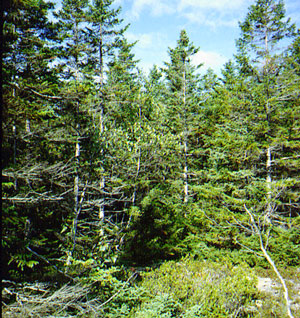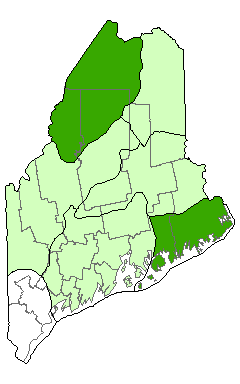DACF Home → Bureaus & Programs → Maine Natural Areas Program → Communities, Plants, and Animals → Natural Community Fact Sheets → Black Spruce Woodland
Printer Friendly Fact Sheet - 1.1 MB pdf (Get a free copy of Adobe Acrobat Reader)
Black Spruce Woodland
Scientific Name: Black Spruce Woodland; State Rank: S3

- Community Description
- Soil and Site Characteristics
- Diagnostics
- Similar Types
- Conservation, Wildlife and Management Considerations
- Distribution
- Characteristic Plants
- Associated Rare Plants
- Associated Rare Animals
- Examples on Conservation Lands You Can Visit
Community Description: These are boreal, open canopy woodlands in which black spruce is strongly dominant but is sometimes mixed with red spruce or white pine. Trees are stunted and canopy closure is usually less than half, although occasionally a site may have a more closed canopy (~85%). The shrub layer often has smaller black spruce and a scattering of evergreen and deciduous shrubs. The herb layer is usually extensive (>50% cover) and strongly dominated by heath shrubs. Herbs comprise <5% of the herb layer cover; bracken fern and bunchberry are typical. The bryoid layer is fairly well developed (>15% cover) and may be prominent, with abundant reindeer lichens. Peat mosses may be present in low pockets but are not abundant. Back to top.
Soil and Site Characteristics: Sites are upland or transitional wetland-upland and are on flat or slightly sloping ground. Substrate is bedrock with only a thin patchy layer (<12 cm) of sandy soil or poorly decomposed organic duff. At some sites, the sandy substrate is up to 30 cm over till. Soils are acidic (pH ~5.0) and well drained; moisture may accumulate in pockets of the substrate. Sites occur on cool and moist microclimates, mostly at the immediate coast or in northwest Maine at up to ~1200’. Back to top.
Diagnostics: Black spruce is strongly dominant, with canopy closure 25-60%; the dwarf shrub component of the herb layer is well developed and dominated by heaths. Back to top.
Similar Types: Black Spruce Barrens have higher shrub cover and generally occur on deeper, poorly drained mineral soil rather than on bedrock, but the two types may co-occur, and further work is needed to distinguish the two. Black Spruce Bogs can have very similar species composition but grow on saturated peat moss, as part of a peatland. Cold - Air Talus Slopes can have similar species but have <25% tree cover. Back to top.
Conservation, Wildlife and Management Considerations: Sites appear to receive little human impact other than some light recreational use. Some sites may be of fire origin.
A variety of conifer-nesting birds may use this habitat, including blackpoll warbler, bay-breasted warbler, and black-backed woodpecker. The only modern occurrence in Maine of the rare purple lesser fritillary butterfly is found within the northernmost example of this community type. Back to top.
Distribution: Known sites occur on either Downeast islands or extreme northwest Maine. More broadly, this type occurs in the Laurentian Mixed Forest Province, extending northward and eastward. Landscape Pattern: Small Patch. Back to top.


Characteristic Plants: These plants are frequently found in this community type. Those with an asterisk are often diagnostic of this community.
- Canopy
- Black spruce*
- Red spruce
- Sapling/shrub
- Black huckleberry*
- Black spruce*
- Gray birch*
- Wild-raisin*
- Dwarf Shrub
- Black huckleberry*
- Lowbush blueberry*
- Sheep laurel*
- Bryoid
- Dicranum moss
- Reindeer lichen
There are no documented rare plants associated with this natural community.
- Purple lesser fritillary
Examples on Conservation Lands You Can Visit
There are no documented examples on conservation lands that you can visit associated with this natural community.